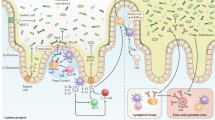Abstract
The human host and its microbial flora constitute a complex ecosystem whose equilibrium serves as a remarkable example of reciprocal adaptation. Intestinal bacteria play an important role in the development of the immune system. The normal intestinal flora is responsible for resistance to colonization by exogenous pathogenic microorganisms. Nevertheless, it also constitutes a reservoir of potentially pathogenic bacteria in close contact with the host. These bacteria are responsible for opportunistic infections in immunocompromised hosts. The equilibrium of the flora can be upset by antibiotics, leading to infections as a result of proliferation of antibiotic-resistant pathogenic bacteria.
Similar content being viewed by others
References
Dubos R, Schaedler RW The digestive tract as an ecosystem. American Journal of Medical Sciences 1964, 248: 267–271.
Freter R Experimental entericShigella andVibrio infections in mice and guinea pigs. Journal of Experimental Medicine 1956, 104: 411–418.
Ducluzeau R, Bellier M, Raibaud P Transit digestif de divers inoculum bactériens introduits per os chez des souris axéniques et holoxéniques: effet antagoniste de la microflore du tractus gastrointestinal. Zentralblatt für Bakteriologie und Parasitenkunde, Infektionskrankheit und Hygiene 1970, 213: 533–548.
Van der Waaij D, Berghuis de Vries JM, Lekkerker JEC Colonization resistance of the digestive tract in conventional and antibiotic treated mice. Journal of Hygiene of Cambridge 1971, 69: 405–411.
Freter R, Brickner H, Botney M, Cleven D, Aranki A Mechanisms which control bacterial populations in continuous flow culture models of mouse large intestinal flora. Infection and Immunity 1983, 39: 676–685.
Savage DC Associations of indigenous microorganisms with gastrointestinal epithelial surfaces. In: Hentges DJ (ed): Human intestinal microflora in health and disease. Academic Press, New York, 1983, p. 55–74.
Steffen EK, Berg RD, Deitch EA Comparison of translocation rates of various indigenous bacteria from the gastrointestinal tract to the mesenteric lymph node. Journal of Infectious Diseases 1988, 157: 1032–1038.
Wells CL, Maddaus MA, Simmons RL Proposed mechanisms for the translocation of intestinal bacteria. Reviews of Infectious Diseases 1988, 10: 958–978.
Holmberg SD, Osterholm MT, Seneger KA, Cohen ML Drug-resistantSalmonella from animals fed antimicrobials. New England Journal of Medicine 1984, 311: 617–622.
Tancrède CH, Andremont AO Bacterial translocation and gram-negative bacteremia in patients with hematological malignancies. Journal of Infectious Diseases 1985, 152: 99–103.
Nord CE, Heimdahl A, Kager L Antimicrobial induced alterations of the human oropharyngeal and intestinal microflora. Scandinavian Journal of Infectious Diseases 1986, 49: 64–72.
Lemozy J Antibiotic resistant enterobacteria in the digestive tract of city dwellers. Sciences et Techniques des Animaux de Laboratoire 1976, i: 170–171.
Tancrède C Méthodes clinique et expérimentale d'évaluation de l'impact écologique d'un antibiotique sur la flore intestinale. Médecine et Maladies Infectieuses 1988, 18: 14–20.
Levy SB, Fitzgerald GB, Macone AB Changes in intestinal flora of farm personnel after introduction of a tetracycline-supplemented feed on a farm. New England Journal of Medicine 1986, 295: 583–588.
Lyerly DM, Krivan HC, Wilkins TD Clostridium difficile: its disease and toxins. Clinical Microbiology Reviews 1988, 1: 1–18.
Rolfe RD, Finegold SM Intestinal β-lactamase activity in ampicillin-induced,Clostridium difficile associated ileocecitis. Journal of Infectious Diseases 1983, 17: 227–235.
Leonard F, Andremont A, Lerclercq B, Labia R, Tancrède C Use of β-lactamase-producing anaerobes to prevent ceftriaxone from degrading intestinal resistance to colonization. Journal of Infectious Diseases 1989, 160: 274–280.
Kolars JC, Levitt MD, Aouji M, Savaino DA Yogurt, an autodigesting source of lactose. New England Journal of Medicine 1984, 310: 1–3.
Gorbach S, Goldin B The intestinal microflora and the colon cancer connection. Reviews of Infectious Diseases 1990, 12, Supplement 2: 252–261.
Author information
Authors and Affiliations
Rights and permissions
About this article
Cite this article
Tancrède, C. Role of human microflora in health and disease. Eur. J. Clin. Microbiol. Infect. Dis. 11, 1012–1015 (1992). https://doi.org/10.1007/BF01967791
Issue Date:
DOI: https://doi.org/10.1007/BF01967791




